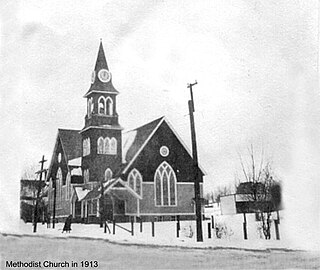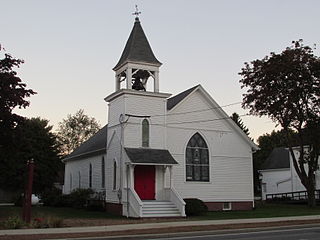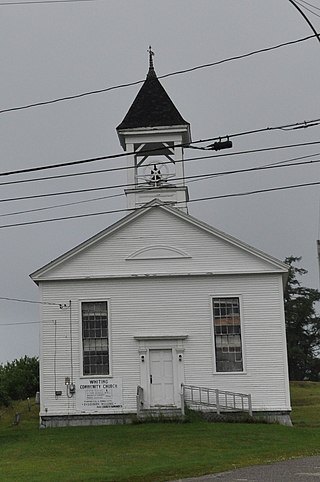
The Winton Place Methodist Episcopal Church is a historic church building in the Winton Place neighborhood of Cincinnati, Ohio, United States that was constructed as the home of a congregation of the Methodist Episcopal Church in the late nineteenth century. The congregation grew out of a group that was founded in 1856; although the members erected their first building in 1860, they were not officially organized until 1872. Among the leading members of the congregation was Samuel Hannaford, a prominent Cincinnati architect. When the congregation chose to build a new church building in 1884, Hannaford was chosen as the architect for the project. At this time, Hannaford was near to the peak of his prestige: he had ended a partnership with another architect seven years before, and his reputation was growing with his designs of significant Cincinnati-area buildings such as the Cincinnati Music Hall.

The First Universalist Church is a historic church building on the corner of Pleasant, Elm, and Spring Streets in Auburn, Maine. It was built in 1876 to a design by John Stevens of Boston, Massachusetts, and has been a significant landmark in the city since its construction. It is a fine local example of Gothic Revival architecture executed in brick, and was listed on the National Register of Historic Places in 1979.

The Prayer Temple of Love Cathedral is located at 12375 Woodward Avenue in Highland Park, Michigan. It was built in 1929 as the Grace Evangelical Lutheran Church, and was listed on the National Register of Historic Places in 1982.

The Gray Memorial United Methodist Church and Parsonage is a historic church complex at 8 Prospect Street in Caribou, Maine. The Gothic Revival wood-frame church, built in 1912-14 for a Methodist congregation founded in 1860, is the most architecturally sophisticated church in Caribou. It was built on the lot of the Colonial Revival parsonage house, which was moved to make way for the church. The complex was listed on the National Register of Historic Places in 1995. The current pastor is Pastor Richard Rego.

The Gustaf Adolph Lutheran Church is a historic church at 29 Capitol Hill Road in New Sweden, Maine. The congregation was established by Swedish immigrants to the area in 1871, and the Gothic Revival sanctuary was built in 1879-80. In 1896 the church was named in honor of King Gustavus Adolphus of Sweden. It was listed on the National Register of Historic Places in 1997. The church congregation was in 2003 subjected to one of the nation's largest cases of arsenic poisoning, perpetrated by one of its parishioners.
The Maple Grove Friends Church is a historic Quaker meeting house on U.S. Route 1A in the Maple Grove village of southern Fort Fairfield, Maine. Built in 1863 and renovated in 1906, it is believed to be the oldest ecclesiastical building in the Fort Fairfield area and the northernmost station on the Underground Railroad. It was listed on the National Register of Historic Places in 2000.

St. David Catholic Church is a historic church at 774 Main Street in Madawaska, Maine. Built in 1911, it is an architecturally distinctive blend of Baroque revival and Italian Renaissance revival architecture. The congregation was the first separate Roman Catholic congregation established in Madawaska, the result of many years' struggle, after the international border divided the French Catholic community here in 1842. The building was listed on the National Register of Historic Places in 1973.

The West Scarborough United Methodist Church, also known as the Dunstan Methodist Episcopal Church, is a historic church on U.S. Route 1 in Scarborough, Maine. The church building, built in 1839 and extensively altered in 1907, is one of the few surviving works of Maine architect and artist Harry Hayman Cochrane. The building was listed on the National Register of Historic Places in 1989 for its architectural significance.

The Elm Street Congregational Church and Parish House is a historic church complex at Elm and Franklin Streets in Bucksport, Maine. It includes a Greek Revival church building, built in 1838 to a design by Benjamin S. Deane, and an 1867 Second Empire parish house. The church congregation was founded in 1803; its present pastor is the Rev. Stephen York. The church and parish house were listed on the National Register of Historic Places in 1990.

The Church of the New Jerusalem, now known as The Fryeburg New Church, is a congregation of The New Church (Swedenborgianism) at 12 Oxford Street in Fryeburg, Maine. The historic church building is a Stick style structure designed by Portland architect, Charles H. Kimball, and built in 1878. It was listed on the National Register of Historic Places in 1986.
Dexter Universalist Church, or the First Universalist Church of Dexter, is a historic church on Church Street in Dexter, Maine. Built in the 1820s and restyled in the 1860s, it is a distinctive work of Boston, Massachusetts architect Thomas Silloway. The building was listed on the National Register of Historic Places in 1985.
The Springfield Congregational Church is a historic church on Maine State Route 6 in Springfield, Maine. Built in 1852, it is Gothic Revival building noted for its elegance and high quality despite its rural setting. The building was listed on the National Register of Historic Places in 1978.

The Former Free Will Baptist Church is a historic church building at 12 High Street in Milo, Maine. It is home to the Milo Historical Society Museum. Built in 1853, this wood-frame structure was Milo's first church, shared initially by Baptist and Free Will Baptist congregations before becoming the exclusive property of the latter. It has served as the local history museum since 1996. The building was listed on the National Register of Historic Places in 2000.

The Mercer Union Meetinghouse is a historic church in Mercer, Maine, USA. Built in 1829 for several different denominations to share, this church is a relatively early and rare example of transitional Federal-Gothic styling in the state, with its tower set partially over the entrance vestibule, another uncommon feature. The building was listed on the National Register of Historic Places in 2007.

West Haven Baptist Church is a historic church at 48 Book Road in West Haven, Vermont. Built in 1831 with later alterations, it is a good local example of Federal and Gothic architecture with a Victorian interior. It was listed on the National Register of Historic Places in 2007.

St. Paul's Episcopal Church is a parish church in the Diocese of Iowa. The church is located in Harlan, Iowa, United States. It has been listed on the National Register of Historic Places in 1978.

The former Surry Town Hall is located at 1217 Surry Road in the village of Surry, Maine. Built in East Surry in 1848, it served as town hall until 1844, and as a combined church and town hall until about 1881. It was then returned to exclusive municipal use until 1978; it is now home to the Surry Historical Society. It was listed on the National Register of Historic Places in 2008. The town's municipal offices are located in a modern facility on North Bend Road; town meetings are now held in the local school auditorium.
St. John Catholic Church is a historic church building on St. John Street in St. John Plantation, Maine. Built between 1909 and 1911, it is a finely-detailed and handsome example of religious Colonial Revival architecture in a remote rural setting. The building was listed on the National Register of Historic Places in 2003.

The Union Meeting House, also known as the Whiting Community Church, is a historic church building at 153 United States Route 1 in Whiting, Maine. Built in 1836, it is a distinctive local example of transitional Federal-Greek Revival architecture. It was listed on the National Register of Historic Places in 2014.

The Elk Rapids First Methodist Episcopal Church is a former church located at 301 Traverse Street in Elk Rapids, Michigan. The building now houses Elk Rapids Area Historical Museum. It was listed on the National Register of Historic Places in 2015.

















